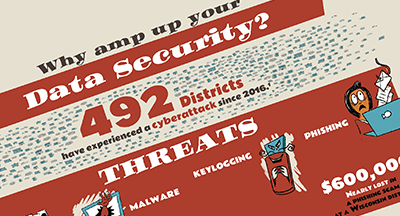
As that great analytics expert Dolly Levi noted in the classic tale of love among the spreadsheets, Hello, Dolly!, “Data is like manure. It’s not worth a thing unless it’s spread around, encouraging young things to grow.”
Actually, Dolly wasn’t a data scientist at all, and she was talking about money and not data—but these days, data is money.
Your district’s data is too important to remain locked away in spreadsheets or sitting unused in your ERP. Your data needs to be put to work identifying trends and suggesting opportunities, so your district can take proactive action on fundamental problems.
In addition, truly forward-thinking districts are merging their data with data from external sources to get a fuller picture of the dynamics shaping their communities, in order to better prepare for the future.
Want to be your district’s very own Magic 8-Ball? Here’s where to start.
Determine what data you have
Start with your own data. Can you name all the types of data your district collects? If not, conduct a data audit.A data audit is exactly what you think it is: an inventory of all the data points you’re collecting across the district, including a description of what the data is, where it’s housed, and how long it’s been collected.
There are two likely outcomes from a data audit:
1) You’ll be amazed at all the data you’re collecting; and/or
2) You can’t believe the data gaps you have.
Both are good outcomes, actually. You might be surprised at what you have when you pull all of this together:
1) Academic achievement: grades and test scores
2) Observational data from teachers
3) Demographic data (age, ethnicity, gender, economic status, special needs, etc.)
4) Attendance and behavior
5) Homework activity
That’s a lot of data! Do you know how happy a business would be to have that amount of data about their customers—and what they might be able to do with it?
Check out the infographic: “What Is Student Data?”
On the other hand, gaps—things like incomplete capture of observational data—are good to know, because now you can take corrective steps.
Put your data to work
After you’ve completed your data audit, look at the results and ask two questions:1) How are we using this data now?
2) How could we use this data in the future?
You can get pretty creative with the second point. Here’s an example.
After the latest round of remote learning, districts have detailed data on students’ technology access and level of technological proficiency.
How is that data being used now? Quite likely it’s not being used at all. But it can be added to demographic data (gender, ethnicity, income) and academic performance data to produce measures of technology’s impact on academic performance by demographic category.
With a multi-dimensional understanding of this issue, you can start to improve. whether that means keeping schools’ technology centers open longer or teaming with a local university to enable students to access their computers.
If you don’t have this data going back years, don’t worry. Start now, which creates a benchmark, then measure from there moving forward.
Asking the same questions and measuring the same things over time is incredibly powerful. Multiple, longitudinal data points are better than one, but any data can help answer some big questions and ultimately shape a district’s direction.
Augment your data
The fuller the picture you have of your students, their families, and your community, the better you can meet their needs.Regardless of the data you have on hand, you can always stand to collect more. These strategies can up your data game:
Surveys
Some districts introduce surveys and don’t ask the right questions.Other districts shy away from surveys because they’re afraid that asking a question about a difficult topic implies that the district will solve it … which they might not be able to do.
Without getting too deep into survey stuff, here are some ways to maximize your survey opportunities:
- Have a clear purpose or research question you want the survey to address—and don't conduct a survey just to prove your side of an argument
- Minimize the number of “open-ended” questions; they encourage venting and require lots of time to analyze
- Ask clear questions and give respondents clear choices
- Be consistent; if your first one-to-five scale goes from most positive to most negative, make sure all your scales go that same direction
- If you anticipate significant pushback on money-related questions, ask questions about training or resources instead
- When analyzing the survey, let the data guide your conclusions, and don’t try to “fudge” negative sentiment
- Combine survey data with other data to provide a more well-rounded picture of an issue
Census data
The Census Bureau has an amazing amount of data available for download. If you’re looking for an extremely detailed demographic portrait of your community or county tracked over time, census data is the way to go.While getting the right census data isn’t exactly a piece of cake, there is a method to it. Go to https://data.census.gov/cedsci/ and enter what you’re searching for. Use their Filter function to narrow down results by geographical area or other demographics, and ultimately you’ll see scads of one-, five-, and 10-year-old data tables you can download and merge with your own data.
Best of all: it’s free.
Business development data
You might not think of using data on business activity, but it can actually provide a detailed economic snapshot of your community that can help you project future growth, educational needs and opportunities, and much more.Getting the data is easy. Ask your local chamber of commerce or business council if they have a business and economic profile of your community or county. If there’s a university in your community with an economics department, ask them if they collect data on the local economy.
Comparing this data with your own data on curriculum and educational achievement can help point up disparities, gaps, and opportunities to partner with the business community on win-win programs that can be a boon to your district.
These days, data is not just money but power—and you have access to a lot of data. Collect it assiduously and use it wisely, and your district will reap the rewards.
Follow-up resource: Data's #1 job
What better use for data than to make kids' lives better? Find out how to get started in Optimize Student Data as an Agent for Change.WHAT'S NEXT FOR YOUR EDTECH? The right combo of tools & support retains staff and serves students better. We'd love to help. Visit skyward.com/get-started to learn more.

|
Erin Werra Blogger, Researcher, and Edvocate |
Erin Werra is a content writer and strategist at Skyward’s Advancing K12 blog. Her writing about K12 edtech, data, security, social-emotional learning, and leadership has appeared in THE Journal, District Administration, eSchool News, and more. She enjoys puzzling over details to make K12 edtech info accessible for all. Outside of edtech, she’s waxing poetic about motherhood, personality traits, and self-growth.




